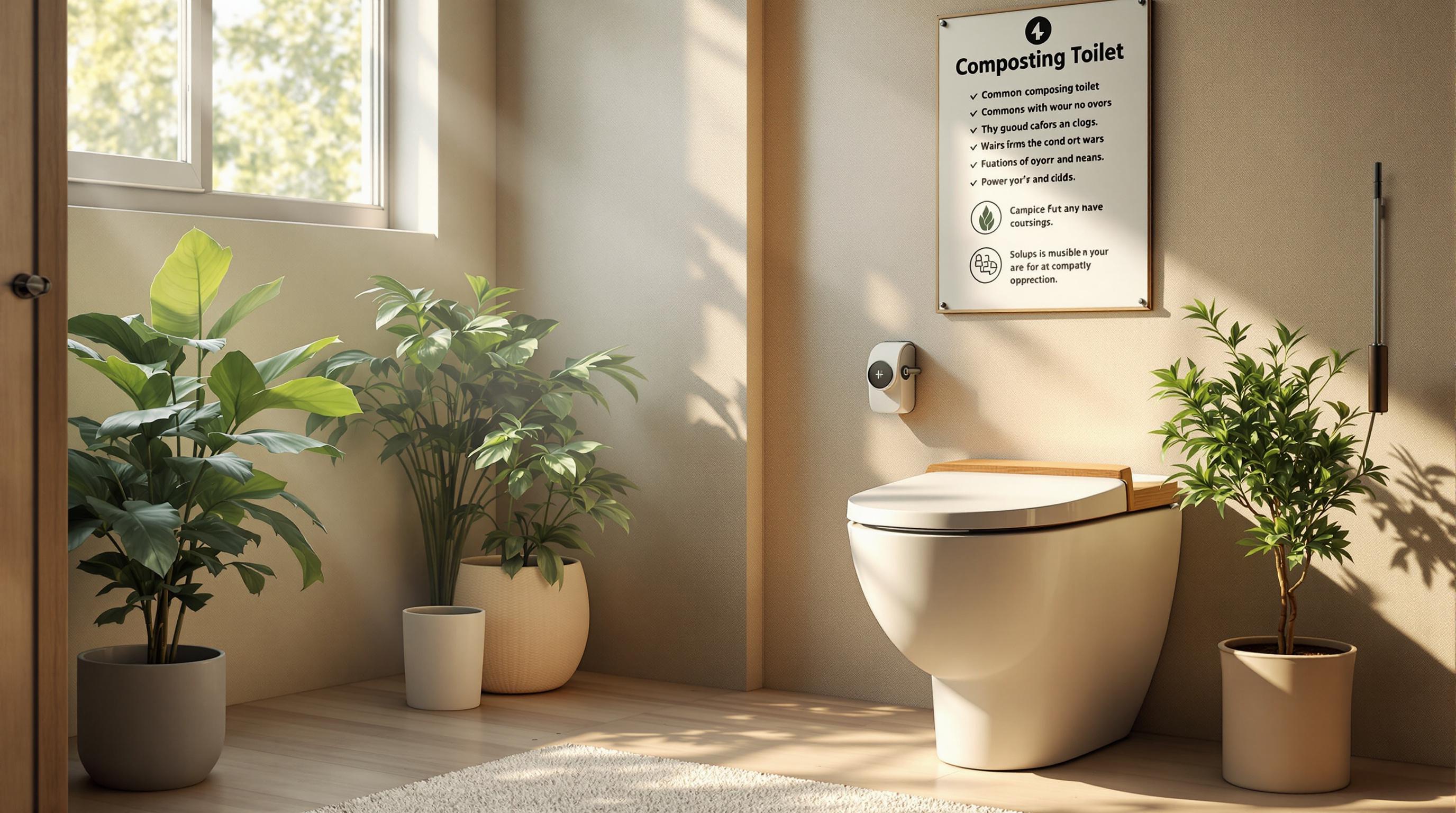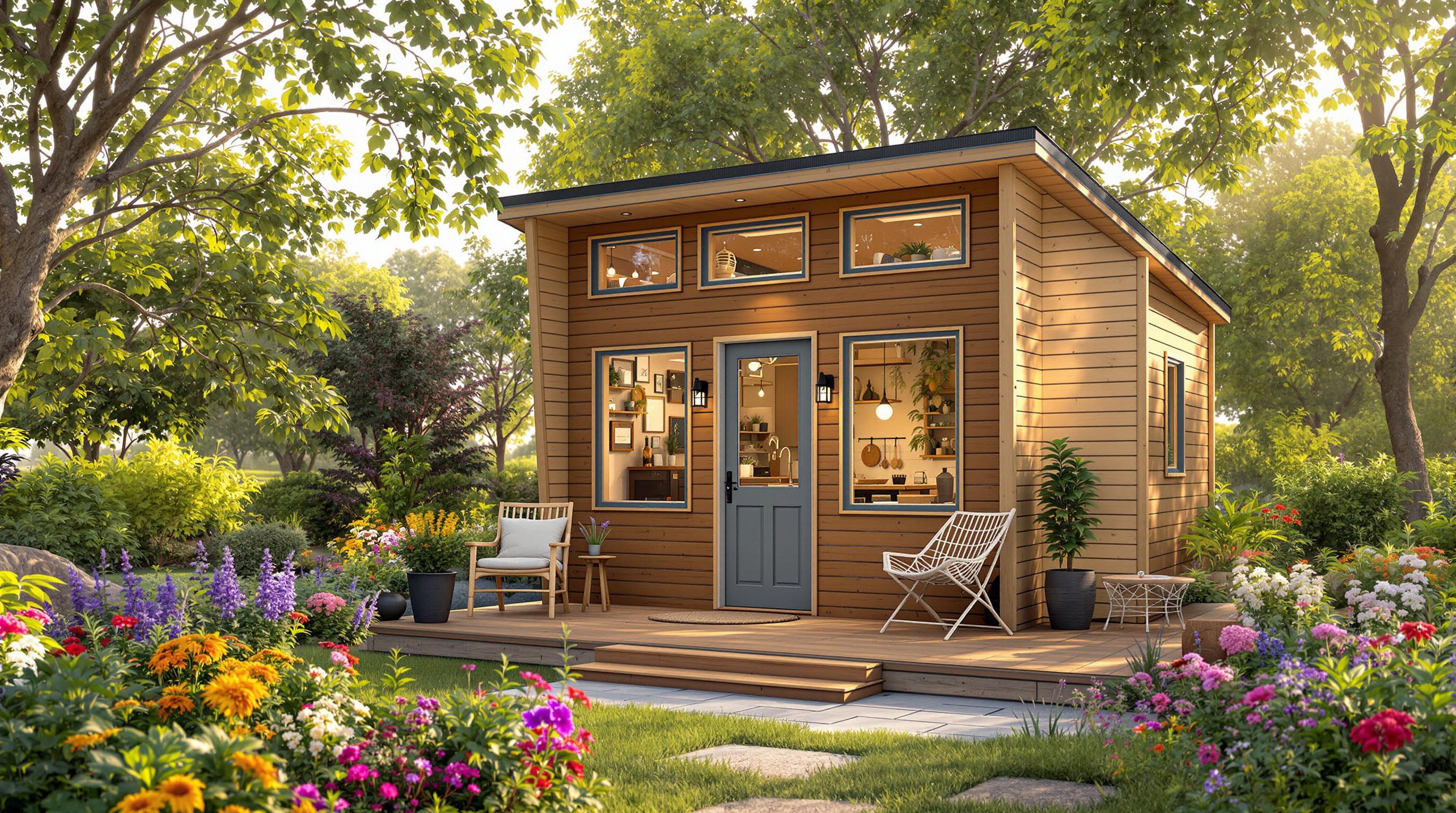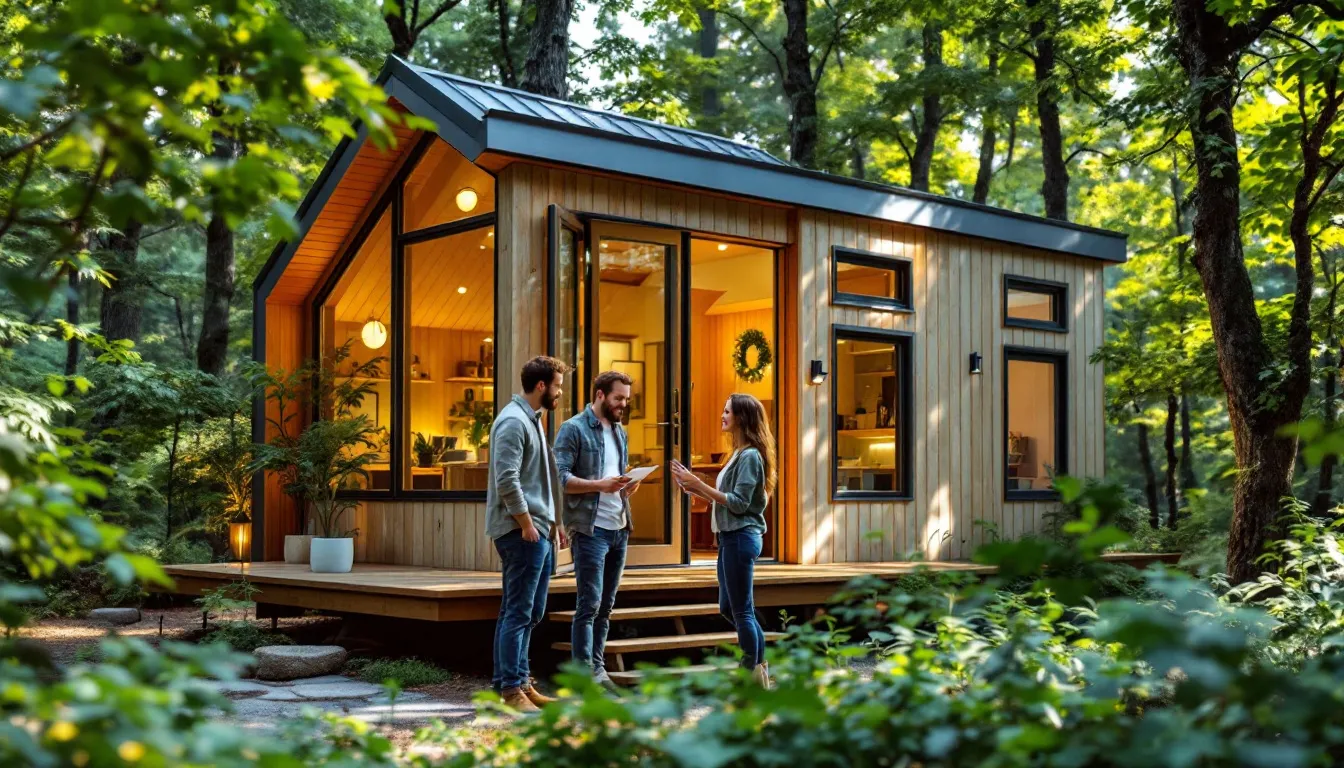Choosing between solar and grid power for your tiny house? Here's what you need to know:
-
Solar power:
- Upfront cost: $10,000 - $20,000
- Monthly bills: Nearly $0
- Lifespan: 25+ years for panels
- Pros: Energy independence, eco-friendly, long-term savings
- Cons: High initial cost, weather-dependent
-
Grid power:
- Initial setup: $1,000 - $8,500
- Monthly bills: $35 - $100
- Lifespan: Indefinite
- Pros: Reliable, lower upfront cost
- Cons: Ongoing bills, less mobility
Quick Comparison:
| Factor | Solar Power | Grid Power |
|---|---|---|
| Initial Cost | High | Low to Moderate |
| Monthly Expenses | Very Low | Moderate |
| Energy Independence | High | Low |
| Mobility | Portable options available | Fixed location |
| Environmental Impact | Low | Varies |
| Maintenance | Occasional | Minimal |
Your best choice depends on your budget, location, and lifestyle. Solar offers long-term savings and freedom, while grid power provides reliability and convenience. Some tiny house owners opt for a hybrid system to get the best of both worlds.
Related video from YouTube
Starting Costs
Let's talk money. Solar and grid power for tiny houses come with different price tags. Here's the breakdown:
Solar Setup Costs
Solar systems for tiny houses? They'll set you back $10,000 to $20,000. It depends on how much juice you need and the quality you're after.
Here's what you're looking at:
| Component | Cost Range |
|---|---|
| Solar Panels (2-4 kW system) | $3,500 - $8,800 |
| Batteries | $2,000 - $5,000 |
| Inverter | $1,000 - $2,000 |
| Installation and Labor | $1,500 - $3,000 |
| Additional Equipment | $1,000 - $2,000 |
Want a ready-made solution? The EcoFlow Power Kit is popular with tiny house folks. It's about $15,000 and gives you everything you need for off-grid living.
Here's a hot tip: There's a 30% federal tax credit for solar. That $15,000 system? It could drop to $10,500 after the credit.
Grid Connection Costs
Hooking up to the grid can be cheaper upfront. But costs can swing wildly based on where you are and how close power lines are.
Here's a rough guide:
| Factor | Cost Range |
|---|---|
| Basic Connection Fee | $250 - $1,500 |
| Electrical Line Installation (per foot) | $5 - $15 |
| New Transformer (if needed) | $3,000 - $7,000 |
| Electrician Labor (per hour) | $50 - $100 |
If you're right next to power lines, you might only pay $1,000. But if you're out in the sticks? Costs can skyrocket.
Take this: 500 feet of electrical line could cost you $4,000 to $12,500, depending on whether it's overhead or underground.
Here's a real-world example: A tiny house owner in rural Colorado shelled out $8,500 for grid connection. That covered a $1,200 connection fee, $6,000 for 400 feet of underground line, and $1,300 for an electrician.
So, what's the bottom line? Solar gives you freedom and potential savings down the road. Grid power is reliable and ready to go. Your choice depends on where you are, what you can spend, and your long-term tiny house dreams.
Monthly Costs
Let's break down the ongoing expenses for powering your tiny house. We'll compare solar and grid power options to help you make an informed decision.
Solar Power Bills
With solar, your monthly electricity bill can drop to almost zero. But there are still some costs to keep in mind:
| Expense | Typical Monthly Cost |
|---|---|
| Electricity | $0 (if fully solar) |
| Maintenance | $33 |
| Battery Replacement Fund | $20-$40 |
Tim Davidson, a tiny house owner, says:
"Our solar setup has basically wiped out our power bill. We only deal with small maintenance costs now."
A few things to remember:
- Solar panels usually last 20-25 years
- You might need to budget $150-$330 for occasional panel cleaning
Grid Power Bills
Grid power costs are more predictable, but often higher:
| Expense | Typical Monthly Cost |
|---|---|
| Electricity | $35-$100 |
| Connection Fees | Varies |
| Propane (if used) | $20 |
Real-world examples:
- A tiny house in North Georgia paid under $48 per month for electricity
- Tim Davidson's tiny house electric bill was around $35
Other costs to factor in:
- Propane refills: $35-$40 for two 20lb tanks (lasts about two months)
- Possible future rate increases
Want to keep grid power costs down? Use LED lights and energy-efficient appliances. An energy-efficient tiny home fridge only costs about $52 a year to run.
When choosing between solar and grid power:
- Solar cuts out most ongoing electricity costs but needs upfront investment
- Grid power is convenient but comes with monthly bills
- Your location and energy use habits will affect which option is best for you long-term
sbb-itb-2ef3f3a
Money Over Time
Let's look at how solar and grid power compare financially for tiny houses in the long run.
When You Break Even
The solar payback period is key for tiny house owners. Here's a quick comparison:
| Factor | Solar Power | Grid Power |
|---|---|---|
| Initial Cost | $10,000 - $20,000 | $1,000 - $8,500 |
| Annual Savings | $250 - $750 | N/A |
| Payback Period | 4 - 9 years | N/A |
For solar, your payback period depends on your setup and location. Let's break it down:
A 3 kW system costs about $5,985 after the 30% federal tax credit. If you save $500 annually on electricity, you'd break even in about 12 years.
But here's the kicker: in states like Hawaii or Massachusetts, you could break even in as little as 5 years. Why? Higher electricity costs and more sunshine.
"Solar panels keep converting sunlight into energy even after the payback period - just not as efficiently as when they were new", says Remi Akinwonmi, solar expert and clean energy advocate.
Grid power? There's no real "break-even" point. You're always paying for electricity, but you dodge the upfront costs of solar.
How Long Systems Last
When it comes to longevity, solar has the upper hand:
| Component | Lifespan | Replacement Cost |
|---|---|---|
| Solar Panels | 25+ years | N/A |
| Inverter | 10-15 years | $1,000 - $2,000 |
| Grid Connection | Indefinite | N/A |
Solar panels are tough cookies. Most should work for 25 years before you see any big drop in efficiency. Even then, they don't just quit:
- Top-tier panels only lose 0.30% efficiency each year
- After 25 years, they're still cranking at about 87.5% of their original capacity
The inverter's the weak link. You'll likely need to replace it after 10-15 years. But at $1,000 to $2,000, it's a small slice of your initial investment.
Grid power doesn't need equipment replacement. But you're at the mercy of rising electricity costs. The U.S. has seen average increases of 2.5% annually over the past 25 years. Some states? They've been hit with 10% yearly hikes.
For tiny house owners, this boils down to:
- Solar gives you long-term price stability
- Grid users face a future of unpredictable costs
Take Colorado, for example. A 6 kW solar system can save about $1,350 annually on electric bills. That's an estimated 14% return on investment - almost double what you'd get from a long-term index fund.
Real-Life Factors
Choosing between solar and grid power for your tiny house isn't just about numbers. Let's look at the practical stuff that can sway your decision.
Space and Moving
Your power choice impacts your living space and how easily you can move. Here's the breakdown:
| Factor | Solar Power | Grid Power |
|---|---|---|
| Roof Space | Needs 140 sq ft for 4,380 kWh/year | No roof space needed |
| Interior Space | Room for batteries and inverter | Minimal equipment |
| Mobility | Can be portable | Fixed location |
| Setup/Teardown | Can be tricky | Easy connect/disconnect |
Solar gives you freedom, but it takes up space. Tim Davidson, a tiny house owner, says:
"Our solar setup eats up about 25% of our roof, but it's worth it. We can park anywhere sunny and still have power."
If you move a lot, portable solar systems are a game-changer. The EcoFlow DELTA Pro is popular among tiny house folks. It's compact and quick to set up or pack away - perfect for the 75% of tiny homes that move at least once a year.
Grid power keeps your space clear but ties you down. You need to be near power lines and pay connection fees each time you move.
Power Control
Having reliable power and control over it is key. Here's how solar and grid stack up:
| Aspect | Solar Power | Grid Power |
|---|---|---|
| Reliability | Weather-dependent | Steady (except outages) |
| Power Fluctuations | Might need to watch usage | Stable supply |
| Backup Options | Batteries are a must | Can use a generator |
| Energy Monitoring | Easy with most systems | Extra equipment needed |
Solar puts you in charge. Modern systems like the Renogy 3000W Solar Kit come with apps to track your energy production and use in real-time. This helps you optimize your power use.
But solar has its challenges. Jenna Spesard, who's lived tiny for over 5 years, notes:
"During cloudy weeks, we had to watch our power use closely. Having a small generator as backup was a lifesaver."
Grid power is stable but gives you less control. You're at the mercy of utility companies for rates and outages. But keep in mind, the average U.S. home only loses power for about 2 hours a year, according to the U.S. Energy Information Administration.
Want the best of both? Hybrid systems are catching on. They use solar as the main source but can switch to grid power when needed. They're more complex, but they offer top-notch flexibility for tiny house living.
Conclusion
So, you've explored the world of powering tiny houses. Both solar and grid power have their pros and cons. Let's break it down and help you pick the right option for your tiny home.
Solar vs. Grid: The Showdown
Here's a quick comparison:
| Factor | Solar Power | Grid Power |
|---|---|---|
| Initial Cost | $10,000 - $20,000 | $1,000 - $8,500 |
| Monthly Bills | Almost $0 | $35 - $100 |
| Lifespan | 25+ years (panels) | Indefinite |
| Mobility | Portable options | Fixed location |
| Green Factor | Clean energy | Depends on local grid |
| Energy Independence | High | Low |
Solar power? It's like buying a car instead of renting. Big upfront cost, but long-term savings. A 3 kW system costs about $5,985 after tax credits and can save you $500 a year. It pays for itself in 4-9 years and keeps going for 25-30 years.
Grid power? It's the convenient choice. Cheaper to set up, especially if you're near power lines. But you're stuck with those monthly bills forever.
Making the Call
Think about:
- Where you live: Sunny spots like Hawaii or Massachusetts? Solar might be your best bet.
- Your wallet: Can you handle solar's upfront cost, or is grid power's lower initial investment more your speed?
- Power needs: Most tiny homes are happy with a 1-3 kW solar system. Do the math on your usage.
- Wanderlust: Moving your tiny house often? Look into portable solar systems like the EcoFlow DELTA Pro.
- Space: Solar needs about 140 sq ft of roof for a system pumping out 4,380 kWh/year. Got the room?
- Long-term plans: The longer you use solar, the more you save. Sticking around? Solar could be smart.
- Green dreams: Want to shrink your carbon footprint? Solar's the clear winner.
Here's a thought: Why choose? Some tiny house owners go hybrid - solar as the main power source with grid backup. It's flexible and reliable, especially when it's cloudy or you need extra juice.
FAQs
How much does it cost to solar power a tiny house?
Solar powering a tiny house isn't cheap, but it's doable. Here's the breakdown:
A 1 kW system costs about $3,250 before incentives, or $2,275 after the 30% tax credit. For a 3 kW system, you're looking at $9,750 pre-incentives, or $6,825 post-tax credit.
Most tiny houses need something in this range. But here's the catch:
Tiny houses mean tiny roofs. You've got limited space for panels, so high-efficiency ones are your best bet.
Can't pay upfront? No sweat. Solar loans are a thing.
Now, for the full package (panels, installation, the works), you're typically looking at $15,000 to $20,000. Take the EcoFlow 15kWh Get Set Kit - it's popular with tiny house folks and runs around $18,000. But keep an eye out for discounts.
Solar expert Sarah Johnson puts it in perspective: "A tiny house usually uses about 16 kWh per day, while a regular house gobbles up 30 kWh. This lower energy need makes solar a real option for many tiny homeowners."



